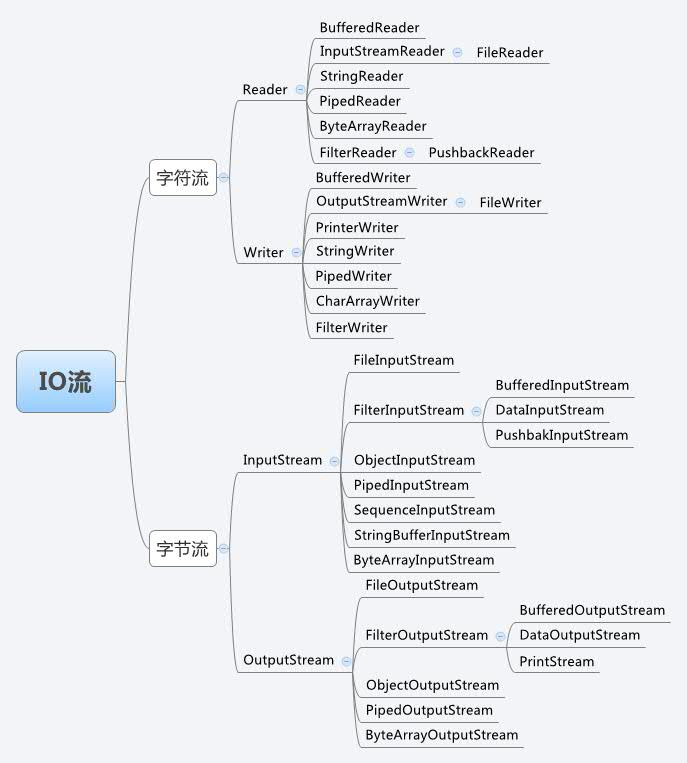java io 一些总结
2016-04-23 10:36
465 查看
首先,java io分为两大阵营,字节流,字符流。结构图如下:

一些常用类的用法以及注意点:
IO流(FileInputStream)
IO流(read()方法返回值为什么是int)
答:因为字节输入流可以操作任意类型的文件,比如图片音频等,这些文件底层都是以二进制形式的存储的,如果每次读取都返回byte,有可能在读到中间的时候遇到111111111。那么这11111111是byte类型的-1,我们的程序是遇到-1就会停止不读了,后面的数据就读不到了,所以在读取的时候用int类型接收,如果11111111会在其前面补上。24个0凑足4个字节,那么byte类型的-1就变成int类型的255了这样可以保证整个数据读完,而结束标记的-1就是int类型。
IO流(FileOutputStream)
IO流(拷贝图片)
IO流(定义小数组的标准格式)
IO流(BufferedInputStream和BufferOutputStream拷贝)
IO流(flush和close方法的区别)
答:
flush()方法:
用来刷新缓冲区的,刷新后可以再次写出 。
close()方法:
用来关闭流释放资源的的,如果是带缓冲区的流对象的close()方法,不但会关闭流,还会再关闭流之前刷新缓冲区,关闭后不能再写出 。
IO流(字节流读写中文)
字节流读取中文的问题
字节流在读中文的时候有可能会读到半个中文,造成乱码
字节流写出中文的问题
字节流直接操作的字节,所以写出中文必须将字符串转换成字节数组
写出回车换行 write(“\r\n”.getBytes());
IO流(流的标准处理异常代码1.6版本及其以前)
IO流(流的标准处理异常代码1.7版本)
原理:
在try()中创建的流对象必须实现了AutoCloseable这个接口,如果实现了,在try后面的{}(读写代码)执行后就会自动调用,流对象的close方法将流关掉
IO流(图片加密)
IO流(字符流FileReader)
IO流(字符流FileWriter)
IO流(字符流的拷贝)
IO流(自定义字符数组的拷贝)
IO流(带缓冲的字符流)
BufferedReader的read()方法读取字符时会一次读取若干字符到缓冲区, 然后逐个返回给程序, 降低读取文件的次数, 提高效率。
BufferedWriter的write()方法写出字符时会先写到缓冲区, 缓冲区写满时才会写到文件, 降低写文件的次数, 提高效率。
IO流(readLine()和newLine()方法)
BufferedReader的readLine()方法可以读取一行字符(不包含换行符号).
BufferedWriter的newLine()可以输出一个跨平台的换行符号”\r\n”.
IO流(使用指定的码表读写字符)
FileReader是使用默认码表读取文件, 如果需要使用指定码表读取, 那么可以使用InputStreamReader(字节流,编码表)。
FileWriter是使用默认码表写出文件, 如果需要使用指定码表写出, 那么可以使用OutputStreamWriter(字节流,编码表)。

一些常用类的用法以及注意点:
IO流(FileInputStream)
FileInputStream fis = new FileInputStream("aaa.txt"); //创建一个文件输入流对象,并关联aaa.txt
int b; //定义变量,记录每次读到的字节
while((b = fis.read()) != -1) { //将每次读到的字节赋值给b并判断是否是-1
System.out.println(b); //打印每一个字节
}
fis.close(); //关闭流释放资源IO流(read()方法返回值为什么是int)
答:因为字节输入流可以操作任意类型的文件,比如图片音频等,这些文件底层都是以二进制形式的存储的,如果每次读取都返回byte,有可能在读到中间的时候遇到111111111。那么这11111111是byte类型的-1,我们的程序是遇到-1就会停止不读了,后面的数据就读不到了,所以在读取的时候用int类型接收,如果11111111会在其前面补上。24个0凑足4个字节,那么byte类型的-1就变成int类型的255了这样可以保证整个数据读完,而结束标记的-1就是int类型。
IO流(FileOutputStream)
FileOutputStream fos = new FileOutputStream("bbb.txt"); //如果没有bbb.txt,会创建出一个
//fos.write(97); //虽然写出的是一个int数,但是在写出的时候会将前面的24个0去掉,所以写出的一个byte
fos.write(98);
fos.write(99);
fos.close();IO流(拷贝图片)
FileInputStream fis = new FileInputStream("01.mp3"); //创建输入流对象,关联01.mp3
FileOutputStream fos = new FileOutputStream("copy.mp3");//创建输出流对象,关联copy.mp3
int b;
while((b = fis.read()) != -1) {
fos.write(b);
}
fis.close();
fos.close();IO流(定义小数组的标准格式)
FileInputStream fis = new FileInputStream("01.mp3");
FileOutputStream fos = new FileOutputStream("copy.mp3");
int len;
byte[] arr = new byte[1024 * 8]; //自定义字节数组
while((len = fis.read(arr)) != -1) {
//fos.write(arr);
fos.write(arr, 0, len); //写出字节数组写出有效个字节个数
}
fis.close();
fos.close();IO流(BufferedInputStream和BufferOutputStream拷贝)
FileInputStream fis = new FileInputStream("01.mp3"); //创建文件输入流对象,关联致01.mp3
BufferedInputStream bis = new BufferedInputStream(fis); //创建缓冲区对fis装饰
FileOutputStream fos = new FileOutputStream("copy.mp3"); //创建输出流对象,关联copy.mp3
BufferedOutputStream bos = new BufferedOutputStream(fos); //创建缓冲区对fos装饰
int b;
while((b = bis.read()) != -1) {
bos.write(b);
}
bis.close(); //只关装饰后的对象即可
bos.close();IO流(flush和close方法的区别)
答:
flush()方法:
用来刷新缓冲区的,刷新后可以再次写出 。
close()方法:
用来关闭流释放资源的的,如果是带缓冲区的流对象的close()方法,不但会关闭流,还会再关闭流之前刷新缓冲区,关闭后不能再写出 。
IO流(字节流读写中文)
字节流读取中文的问题
字节流在读中文的时候有可能会读到半个中文,造成乱码
字节流写出中文的问题
字节流直接操作的字节,所以写出中文必须将字符串转换成字节数组
写出回车换行 write(“\r\n”.getBytes());
IO流(流的标准处理异常代码1.6版本及其以前)
FileInputStream fis = null;
FileOutputStream fos = null;
try {
fis = new FileInputStream("aaa.txt");
fos = new FileOutputStream("bbb.txt");
int b;
while((b = fis.read()) != -1) {
fos.write(b);
}
} finally {
try {
if(fis != null)
fis.close();
}finally {
if(fos != null)
fos.close();
}
}IO流(流的标准处理异常代码1.7版本)
try(
FileInputStream fis = new FileInputStream("aaa.txt");
FileOutputStream fos = new FileOutputStream("bbb.txt");
MyClose mc = new MyClose();
){
int b;
while((b = fis.read()) != -1) {
fos.write(b);
}
}原理:
在try()中创建的流对象必须实现了AutoCloseable这个接口,如果实现了,在try后面的{}(读写代码)执行后就会自动调用,流对象的close方法将流关掉
IO流(图片加密)
BufferedInputStream bis = new BufferedInputStream(new FileInputStream("a.jpg"));
BufferedOutputStream bos = new BufferedOutputStream(new FileOutputStream("b.jpg"));
int b;
while((b = bis.read()) != -1) {
bos.write(b ^ 123);
}
bis.close();
bos.close();IO流(字符流FileReader)
FileReader fr = new FileReader("aaa.txt"); //创建输入流对象,关联aaa.txt
int ch;
while((ch = fr.read()) != -1) { //将读到的字符赋值给ch
System.out.println((char)ch); //将读到的字符强转后打印
}
fr.close();IO流(字符流FileWriter)
FileWriter fw = new FileWriter("aaa.txt");
fw.write("aaa");
fw.close();IO流(字符流的拷贝)
FileReader fr = new FileReader("a.txt");
FileWriter fw = new FileWriter("b.txt");
int ch;
while((ch = fr.read()) != -1) {
fw.write(ch);
}
fr.close();
fw.close();IO流(自定义字符数组的拷贝)
FileReader fr = new FileReader("aaa.txt"); //创建字符输入流,关联aaa.txt
FileWriter fw = new FileWriter("bbb.txt"); //创建字符输出流,关联bbb.txt
int len;
char[] arr = new char[1024*8]; //创建字符数组
while((len = fr.read(arr)) != -1) { //将数据读到字符数组中
fw.write(arr, 0, len); //从字符数组将数据写到文件上
}
fr.close(); //关流释放资源
fw.close();IO流(带缓冲的字符流)
BufferedReader br = new BufferedReader(new FileReader("aaa.txt")); //创建字符输入流对象,关联aaa.txt
BufferedWriter bw = new BufferedWriter(new FileWriter("bbb.txt")); //创建字符输出流对象,关联bbb.txt
int ch;
while((ch = br.read()) != -1) { //read一次,会先将缓冲区读满,从缓冲去中一个一个的返给临时变量ch
bw.write(ch); //write一次,是将数据装到字符数组,装满后再一起写出去
}
br.close(); //关流
bw.close();BufferedReader的read()方法读取字符时会一次读取若干字符到缓冲区, 然后逐个返回给程序, 降低读取文件的次数, 提高效率。
BufferedWriter的write()方法写出字符时会先写到缓冲区, 缓冲区写满时才会写到文件, 降低写文件的次数, 提高效率。
IO流(readLine()和newLine()方法)
BufferedReader的readLine()方法可以读取一行字符(不包含换行符号).
BufferedWriter的newLine()可以输出一个跨平台的换行符号”\r\n”.
BufferedReader br = new BufferedReader(new FileReader("aaa.txt"));
BufferedWriter bw = new BufferedWriter(new FileWriter("bbb.txt"));
String line;
while((line = br.readLine()) != null) {
bw.write(line);
//bw.write("\r\n"); //只支持windows系统
bw.newLine(); //跨平台的
}
br.close();
bw.close();IO流(使用指定的码表读写字符)
FileReader是使用默认码表读取文件, 如果需要使用指定码表读取, 那么可以使用InputStreamReader(字节流,编码表)。
FileWriter是使用默认码表写出文件, 如果需要使用指定码表写出, 那么可以使用OutputStreamWriter(字节流,编码表)。
BufferedReader br = //高效的用指定的编码表读
new BufferedReader(new InputStreamReader(new FileInputStream("UTF-8.txt"), "UTF-8"));
BufferedWriter bw = //高效的用指定的编码表写
new BufferedWriter(new OutputStreamWriter(new FileOutputStream("GBK.txt"), "GBK"));
int ch;
while((ch = br.read()) != -1) {
bw.write(ch);
}
br.close();
bw.close();
相关文章推荐
- java对世界各个时区(TimeZone)的通用转换处理方法(转载)
- java-注解annotation
- java-模拟tomcat服务器
- java-用HttpURLConnection发送Http请求.
- java-WEB中的监听器Lisener
- Android IPC进程间通讯机制
- Android Native 绘图方法
- Android java 与 javascript互访(相互调用)的方法例子
- 介绍一款信息管理系统的开源框架---jeecg
- 聚类算法之kmeans算法java版本
- java实现 PageRank算法
- PropertyChangeListener简单理解
- c++11 + SDL2 + ffmpeg +OpenAL + java = Android播放器
- 插入排序
- 冒泡排序
- 堆排序
- 快速排序
- 二叉查找树
